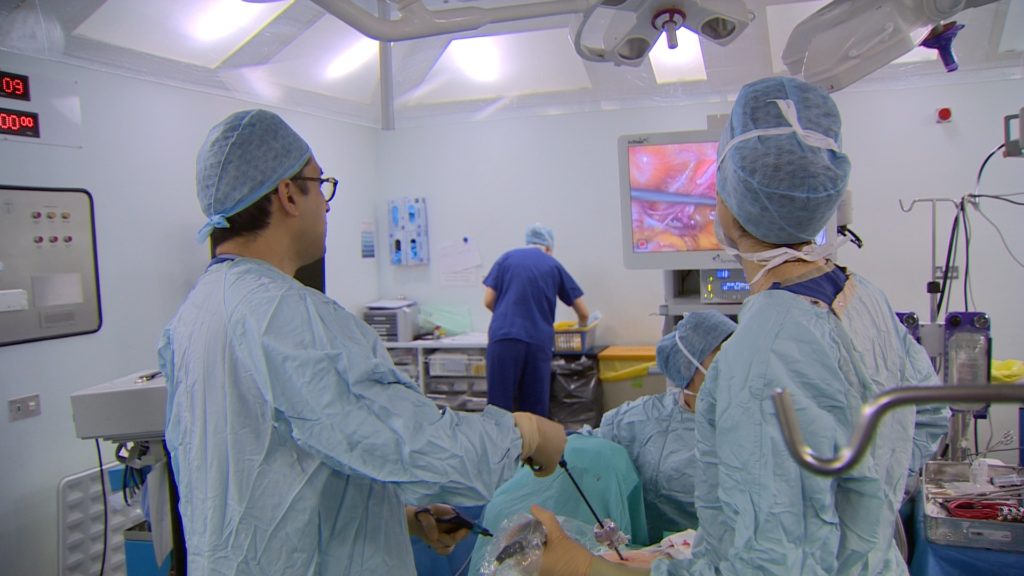Many gynaecological operations can be carried out in a minimally invasive way, through the laparoscope, as well as by an open procedure. It is easy to focus on the smaller scars but the differences are much more than skin deep.
As a Laparoscopic Gynaecological Surgeon, you would probably expect me to say that operating through the laparoscope is superior – and you’d be right. But it’s not just about personal preference, there is good evidence that for many gynaecological problems laparoscopy can offer better results, quicker recovery and fewer complications. In short, it allows the surgeon to do a better job. Indeed, for many procedures, a minimally invasive approach is becoming the gold standard.
When you are asking your GP to refer you to a surgeon, it’s important to bear in mind that all gynaecologists have different strengths and weaknesses. Some may be expert at open operations, treating infertility or cancer. You need to see the surgeon that is right for you, with extensive experience in your condition and the surgery that can help you. Here are seven reasons why you should ask for a surgeon who is practised and passionate about operating laparoscopically.
An eye for detail
The surgeon simply has a better view using the laparoscopic route. Through the camera, the images are magnified by up to seven times so that it’s possible to see tiny structures, nerves and vessels clearly and easily.
Fifty years ago when laparoscopy was starting, surgeons joked that you wouldn’t expect your plumber to repair a leak through the letterbox; they should open the door and walk in. This is ridiculous, the superior technology means that as a surgeon I can see much more through the scope than I could ever visualise with the naked eye alone.
A delicate touch
The precise instruments, with a diameter of between 3 and 5 mm enable me to carry out much finer and more accurate dissection. Delicate nerves that are vital for sexual enjoyment and bladder function can be identified and preserved. This can be very difficult, if not impossible in an open operation.
Easy access
A woman’s pelvis is a complex structure, the bowel, the bladder and the uterus are all close together and in an open operation it can be difficult to reach some of the deep, dark and distant recesses. I have noticed this particularly when operating on women with endometriosis. The patches can extend deep into the pelvis. Having a narrow camera and fine instruments can enable me to not only reach these areas but also to clearly see them and operate precisely, I can do a better job.
For me, this combination of superior visibility, access and precision is all key to why laparoscopy is particularly beneficial in the treatment and excision of endometriosis.
Rapid recovery
Time and time again, quality research has confirmed that after laparoscopic procedures people get better quicker. They are able to leave hospital, get back on their feet and resume normal life and work in a shorter time.
I recently operated on an enthusiastic equestrian. Three days after her laparoscopic hysterectomy she was back in the saddle, literally. This was brilliant for her- but totally went against all my post-operative advice!
Pain and protection
I’m not going to say that laparoscopy is pain-free. You are having surgery and that will have an impact. However, the pain following a laparoscopic procedure is significantly decreased. There is also a decreased risk of bleeding and infection so that you can bounce back much more quickly.
The cosmetic difference
The scars from laparoscopic surgery are smaller, shorter and less noticeable than those of a midline laparotomy or a bikini-line cut, what we call a Pfannenstiel incision. This looks better and feels better, in time the 5-10mm scars will be hardly noticeable.
A question of safety
In experienced hands, laparoscopic surgery is a safer procedure. You may have heard scare stories because when keyhole surgery was first used the complication rates were high. At the time, surgeons were gaining new skills, learning the process, and the equipment was being developed or fine-tuned.
Now we have excellent equipment, advanced training techniques that include computer-aided simulation and surgeons have become better and better. Some of the complications are significantly lower than with the open equivalents. For example, dangerous post-operative problems like deep vein thrombosis and pulmonary embolism.
The right choice
It is important to always choose a surgeon who has extensive experience in your specific operation. If your gynaecologist is uncomfortable with operating laparoscopically then you should ask for a referral to someone with more experience in that field.
However, it should be said that sometimes it is not possible or sensible to perform a minimally invasive procedure. I am very pro-laparoscopy – but being a good surgeon is about weighing up the benefits and risks for each individual. For example, I recently operated on a woman who had fibroids swelling her uterus to the size of a full-term pregnancy. It would have been frankly foolish to remove this through the keyhole. Sometimes open surgery is the best practice, for example, if an ovarian cyst is thought to be cancerous. Although laparoscopy in the right hands can be hugely beneficial, a one size fits all approach is never right.
